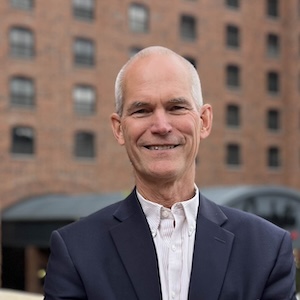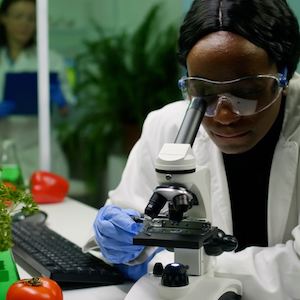An Insightful Q&A with Applied Science Professors
Listen in on a conversation between two regulatory affairs experts and instructors in the Applied Sciences Leadership program about the importance of leadership and other soft skills in the science industry.
Brent Kobielush, PhD, Senior Director, Regulatory Affairs, Conagra Brands
Ruth Petran, PhD, CFS, Senior Advisor, Food Safety, The Acheson Group and Ruth Petran Consulting, LLC
What skills are most critical for success in the sciences right now?
Brent Kobielush: In the food/feed safety and regulatory roles, a delineation between hazard and risk is very important. Hazard is the possibility of something causing harm, whereas risk is the likelihood of a hazard causing harm. Mathematically, risk equals hazard times exposure. As toxicologists, we talk about “dose makes the poison.” Oftentimes, risk assessors are dealing with issues in shades of gray, from what the literature tells us on safety and how to interpret certain regulations throughout the world. All these factors come into play. So, a healthy understanding and comfortability in that gray space is very important, because you're going to be called upon to make decisions. If you continually waffle, no one's going to come to you to make decisions.
I will say from a scientific perspective, the most important thing that someone entering the field should do well is communicate. Communicating PhD-level science isn't easy. If an executive is asking you about a certain issue, you can't use words that may not make any sense except in that academic, scientific sphere, because that individual may not have a scientific background. How you communicate, how you interact with different people, how you make decisions from an integrity and character standpoint, are invaluable. If you can't make relationships up and down the supply chain, cross functionally with peer sets, in other companies, you're going to struggle.
Ruth Petran: I think historically, we've thought about scientists as experts having a lot of deep technical knowledge because they've researched or studied something extensively, which is still a really important starting place. An old mentor of mine always used to say, well, if you ever don't know what to say, always go back to the science, and the science is typically not going to fail you, and that is true. But when we have a particular level of expertise, we have to make sure we communicate this information effectively to whoever the audience is. This means thinking about alternate ways of communicating the same kinds of messages, for example, to a more lay audience who may not have that same technical level of knowledge, but still can benefit from hearing about it.
Critical thinking is really important as well. There's a lot of information out there. With social media and the speed of everything being transmitted, we're bombarded with lots and lots of information. We need to be able to sift through that quickly and ensure that we're communicating what's most accurate. That's where that technical knowledge comes in handy, to make sure that the messages you send forward are valid.
What skills are you looking for when hiring for leadership roles?
Brent Kobielush: I think servant leadership is the strongest leadership quality anybody can have. I think people are saying, well, servant leadership is more of a weakness, you want to be visionary and strategic. I think that's important, but if you aren't advocating [for] or serving the individuals that report to you, that organization is not going to thrive while you're there. That's what I'm looking for as a leader.
More importantly, I believe, is serving the consumers. You and I are consumers; I just happen to be a consumer that works within a food organization. So serving the consumer, doing what's right by them from a safety, regulatory, quality standpoint, in that order, I think is very important. Character is defined as making the right decisions when no one's watching. That has to be part of any leader’s ability to make change, especially in the food safety and regulatory space. If you don't have character and integrity to make solid decisions, then you shouldn't even be interviewing.
Ruth Petran: I think adaptability is really important—being able to take that technical knowledge and apply it in different situations, being ready to be challenged, and standing your ground when it makes sense, but also being open to others' perspectives. The whole idea of risk communication or risk management approaches is making sure that the message you need to get across is going to work for the intended audience and those who need to go out and implement those strategies. It's one thing to come up with a strategy in a laboratory that looks really promising and can earn you a publication, but if it can't be done in the field, it's kind of a failure. So I think adaptability is really key, along with proper communication.
How do you provide growth opportunities for staff?
Brent Kobielush: When we see a great leader, we want to make sure we're elevating and challenging and rewarding them appropriately so that they stay. My approach to leadership is more hands-off than hands-on, because I feel that the more hands-on you are, the more you're viewed as a micromanager. If I get in the way, I'm impeding their growth potential. Not to mention, I'm draining their energy by always looking over their shoulder. Something like that will decimate your organization and the drive of an individual. You're not only doing a detriment to your team, but you're doing a detriment to the broader organization.
There's this whole idea of managing up, and I think that gets talked about as a way of managing your boss. But managing up also is, “Hey, have you thought about this? Maybe we should go this direction?” As a leader, you should allow your employees to express other ideas that you haven’t thought about and have the humility to say, “That's a way better direction than I thought.” Being humble will differentiate you as a leader.
Ruth Petran: I think it’s vital to give folks opportunities to practically apply what is traditionally learned in a four-year college or university. The more opportunities that we all have to get out in the real world and practice these, the better. Approaches can be:
- Allowing staff to take over for the leader when they can, in perhaps a lower risk situation so that they're more likely to succeed
- Letting a junior person craft a message, and then with the leader, reviewing that before it gets sent out
- “Setting them loose” in a sense and letting them try things out and being open to the fact that it's probably not going to be the way I would do it or perfect the first time or ever
But this approach does a couple things ... It recognizes that there are different ways to pull facts together and send that message, and there may be different perspectives. None of us certainly has all the answers. So being open to what others may have experienced or learned in their course of study is key. And giving folks the chance to practice is so helpful and empowering!
How do you work in an integrated way with stakeholders from different industries and backgrounds?
Brent Kobielush: First of all, you’ve got to find the commonality. The goal, as a partner, is to come alongside that individual or that industry and support them in their initiatives, knowing that when you have tough times they're going to come support you. That's how I view collaboration, coming alongside, if it helps that industry. It's human nature to say, they supported me here, we're going to support them there.
Collaboration across industries is important where there is a shared interest of basic principles. We do collaborate across companies because safety is not competitive, and it never should be. So when I was at General Mills I'd call my Kellogg colleague, even though there's fierce competition in that marketplace. Not only is it ethically important to say and live by that, but there's also a business component to it. If they have a problem, it's going to indirectly affect us because the consumers don't see brands as much as they see product categories. Something that impacts one cereal brand will, inevitably, impact the cereal category. Again, ensuring the safety of the food supply is of the utmost importance beyond anything.
Ruth Petran: It's hard to do. But I think doing our best to understand different stakeholders’ points of view is important. For example, business leaders are focused on the bottom line, growth, and maintenance of the business or entity, and communication with them is important. This includes understanding how they can help support the company collectively getting to a more effective and balanced solution.
I've spent a lot of time working with food companies, and I think a food plant is a good analogy for this in that there's typically a quality assurance department, then there's maintenance people, some operators who are working in the plant, the plant manager, various supervisors, probably an HR person. At the end of the day, the goal of that facility is to make food that is saleable, of high quality, and in line with what consumers are going to buy. No one can do that alone. It's only by coming together and understanding how the whole “machine” works together that that goal will be achieved consistently. So everybody has to have the mindset of relying on and working collaboratively with these other functions to reach that common goal.
What about the siloed nature of thinking within certain disciplines?
Brent Kobielush: I use this example all the time when I teach: We’re watching a football game and there's a 30-second commercial for pharmaceutical medication, but the whole 30 seconds is scrolling side effects. But as a consumer, I will take that risk so long as my elbow feels good. Imagine if we put potential side effects in a food commercial. There's this part of us that says food should not have any risk associated with it. Well, anything has risk, it's a matter of driving down the risk. The unique thing in the food or feed industry that the consumer cannot get their arms around is the fact that there's risk with food.
And that's what sets food apart in trying to communicate risk effectively, and no one has gotten it right. There's mercury in fish. If you don't cook chicken, you might have salmonella. If you're using raw dough, there is potential risk there. That's where it's really hard to collaborate, especially on the communication piece.
Ruth Petran: To some extent I think that's just the nature of tradition and “how we've always done things.” I think some of the newer regulations and focuses from the regulatory bodies have forced cooperation and collaboration among these different kinds of silos. It'd be nice if this had been happening on its own, and to some extent, it has, but when you have a regulator pushing something at the industry, it does encourage it, perhaps a little more quickly and effectively.
We know that it works; there's been lots of published work on the value of collaborating. At the end of the day it gives you a better solution than just one entity going at it themselves.
Why does having a blend of soft skills and hard science skills make for effective leadership?
Brent Kobielush: If you 100% know the science but you can't communicate it, it means nothing except to you. Likewise, if you can talk a great game, people are gonna pick that apart by asking harder questions. So you have to have both to be successful. Are there successful individuals who want to focus on the science but can’t explain it? Yeah … but they will hit a ceiling. I think if you want to have the quintessential whole package, you understand the science and you can communicate and translate it. If you can play and work in both ladders, that will set you apart.
We have to have a really firm understanding of what people are capable of and what their potential is. They might have the potential to do it, but they have to want to do it. In some cases, an individual will have to move organizations for the opportunity to lead. This is sometimes a difficult realization. The vast majority of individuals who have deep technical knowledge, as well as an appreciation and knowledge of the business side of things, tend to really accelerate up the ladder.
Ruth Petran: I think it's interesting because 20, 30 years ago, I don't think we would have thought about scientists really needing to have too many soft skills. But as we've seen, with the advent of the internet and more communication channels, there’s a need to be hyperaware of the audience and the need for effective communication in a variety of media.
So now you need to get your message across within a sentence or two, versus in the past you could write a publication or article that would be pages and pages. I think the pandemic certainly demonstrated examples where we had scientists communicating messages that, to them, were very accurate from a research standpoint. But the practical application of getting this information to the general public and having them do something about it failed in some cases. So we need to be able to blend those in order to be more effective as we're working to lead across these industries.
Brent and Ruth teach Regulatory Affairs for Food Production and Distribution (ASCL 6213).












